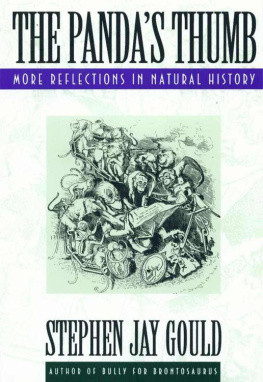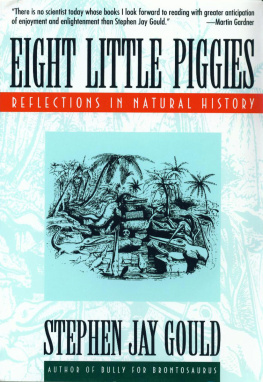Treasures and Oddities of Natural History Collectors from Peter the Great to Louis Agassiz (with R. W. Purcell)
Hens Teeth and Horses Toes
Stephen Jay Gould

W. W. NORTON & COMPANY
NEW YORK LONDON
Phyletic Size Decrease in Hershey Bars: from Junk Food by Charles J. Rubin, David Rollert, John Farago, Rick Stark, Jonathan Etra.
Copyright 1980 by Charles J. Rubin, David Rollert, John Farago, Rick Stark, Jonathan Etra. Used by permission of Dell Publishing Company.
Robert Frost: Design from The Poetry of Robert Frost edited by Edward Connery Lathem. Copyright 1936 by Robert Frost. Copyright 1964 by Lesley Frost Ballantine. Copyright 1969 by Holt, Rinehart and Winston. Reprinted by permission of Holt, Rinehart and Winston, Publishers. Also reprinted by permission of the Estate of Robert Frost and Jonathan Cape Limited, 30 Bedford Square, London.
Copyright 1983 by Stephen Jay Gould
All rights reserved
First published as a Norton 1984; reissued 1994
Library of Congress Cataloging in Publication Data
Gould, Stephen Jay.
Hens teeth and horses toes.
1. Evolution I. Title.
QH366.2.G66 1983 575 82-22259
ISBN: 978-0-393-31103-7
W. W. Norton & Company, Inc.
500 Fifth Avenue, New York, N. Y. 10110
www.wwnorton.com
W. W. Norton & Company Ltd.
Castle House, 75/76 Wells Street, London WIT 3QT
F OR M Y M OTHER
Brave woman
Wise owl
Contents
Three Geologists
Three Biologists
Adaptation
Development
Creationism
Race and Creed
Hens Teeth and Horses Toes
Prologue
ALL THE WORLD LOVES a centennial; we cant resist the temptation to celebrate something clean and even in a ragged and uncertain world. I am gathering this third volume of collected essays in the midst of worldwide festivities for the third Darwinian centennial of our century. The first, in 1909, celebrated the 100th anniversary of Darwins birth; the second, in 1959, the 100th year since publication of the Origin of Species; the third, in 1982, the 100th anniversary of his death. Darwin and evolutionary theory have been the focal point of all my writing in this series (my personal tribute to Darwin on his third centennial appears as essay 9 in this volume). The sequence of centennials provides us with a fine epitome of evolutionary theory in our century, and with some insight into its present successes and tribulations.
The organizers of the major 1909 shindig at Cambridge University had to cover up an embarrassing fact in preparing their hagiographical centennial volume. Although no thinking person doubted the fact of evolution by 1909, Darwins own theory about its mechanismnatural selectionwas not then at the height of its popularity. Indeed, 1909 marked the acme of confusion about how evolution happened in the midst of complete confidence that it had occurred. An embattled group of strict Darwinians, led by the aging A. R. Wallace in England and by A. Weismann in Germany, continued to hold that virtually all evolutionary change occurred by the cumulative power of natural selection building adaptation step-by-step from the random raw material of small-scale genetic variation. Lamarckism remained strong and provided an alternative to natural selection for the gradual building of adaptationscreative organic response to perceived needs and the transmission of these favorable responses to offspring through the inheritance of acquired characters. Mendelian inheritance, when properly elucidated, tipped the scales in Darwins favor; but, in 1909, it had (in the gropings of its youth) merely sown more confusion by adding yet a third mechanism to the swirling competitionproduction of new species all at once by large and fortuitous mutations.
By 1959, confusion had ceded to the opposite undesired state of complacency. Strict Darwinism had triumphed. The flowering of Mendelian genetics had finally laid Lamarckism to rest since the workings of DNA provided no mechanism for an inheritance of acquired characters. Early fascination with large mutations had ceded to a recognition that copious and continuous small-scale variation also had a Mendelian base, and provided a far better source for the raw material of evolutionary change than occasional and detrimental large mutations. But random, small-scale variation produces no change by itself and requires a shaping force to preserve and enhance its favorable component. By 1959, nearly all evolutionary biologists had concluded that natural selection, after all, provided this creative mechanism of evolutionary change. At age 150, Darwin had triumphed. Yet, in the flush of victory, his latter-day disciples devised a version of his theory far narrower than anything Darwin himself would have allowed.
The strict version went well beyond a simple assertion that natural selection is a predominant mechanism of evolutionary change (a proposition that I do not challenge). It emphasized a program for research that almost dissolved the organism into an amalgam of parts, each made as perfect as possible by the slow but relentless force of natural selection. This adaptationist program downplayed the ancient truth that organisms are integrated entities with pathways of development constrained by inheritancenot pieces of putty that selective forces of environment can push in any adaptive direction. The strict version, with its emphasis on copious, minute, random variation molded with excruciating but persistent slowness by natural selection, also implied that all events of large-scale evolution (macroevolution) were the gradual, accumulated product of innumerable steps, each a minute adaptation to changing conditions within a local population. This extrapolationist theory denied any independence to macroevolution and interpreted all large-scale evolutionary events (origin of basic designs, long-term trends, patterns of extinction and faunal turnover) as slowly accumulated microevolution (the study of small-scale changes within species). Finally, proponents of the strict version sought the source of all change in adaptive struggles among individual organisms, thus denying direct causal status to other levels in the rich hierarchy of nature with its individuals both below the rung of organisms (genes, for example) and above (species, for example). The strict version, in short, emphasized gradual, adaptive change produced by natural selection acting exclusively upon organisms.
At the second centennial, some experts even declared that the immense complexity of evolution had yielded to final resolution. One leader remarked in a famous essay: Differences of opinion on relatively minor points naturally persist and many details remain to be filled in, but the essentials of the explanation of the history of life have probably now been achieved.


















